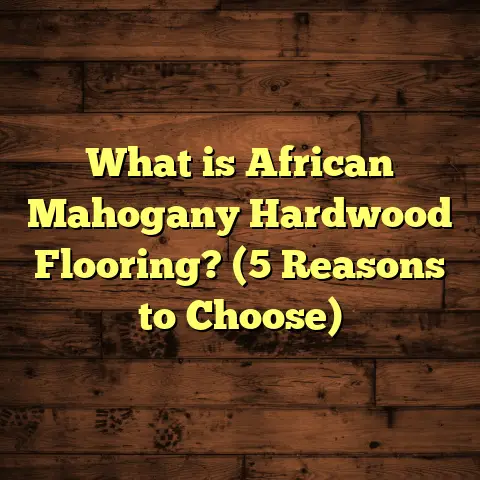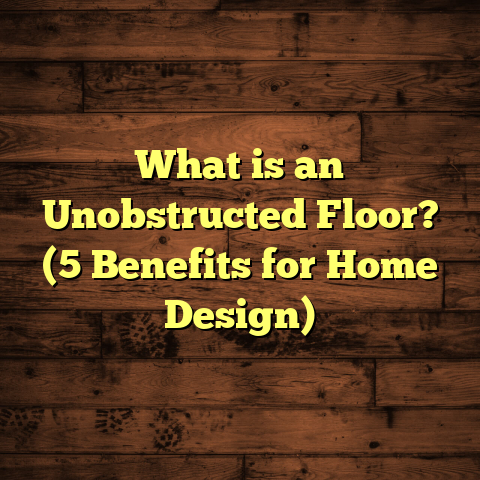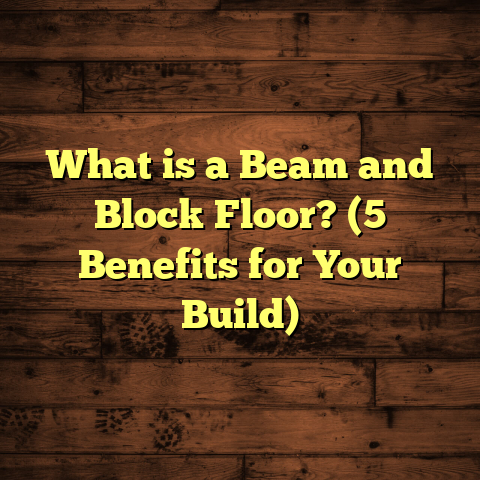What is Wood Look Ceramic Tile Flooring? (5 Benefits You Must Know)
I remember the day clearly when a client called me in a panic. She had just bought her dream home — an old farmhouse with gorgeous hardwood floors that told stories of decades gone by. But then came the kitchen renovation, and the water spills started to show their ugly side. The wood buckled, stained, and cracked. She was heartbroken. But that’s when I suggested something she hadn’t seriously considered before: wood look ceramic tile flooring. It’s not just a compromise; it can sometimes be the best of both worlds.
That moment stuck with me. Since then, I’ve used wood look ceramic tiles in countless projects — from cozy cottages to busy commercial spaces — and every time the reaction is the same: disbelief at how close it comes to real wood, paired with relief at how strong and easy to maintain it is.
If you’re curious about this flooring type, what it really is, and why it might be perfect for you, pull up a chair. I’ll share everything I know.
What Is Wood Look Ceramic Tile Flooring?
Let’s start simple. What is wood look ceramic tile flooring?
At its core, it’s ceramic or porcelain tile made to look like wood planks. Manufacturers use advanced printing technology to apply high-resolution images of natural wood grain onto tiles. Then, they add textured glazes to mimic the feel of real wood. The final product looks just like hardwood but is made of fired clay.
There are two main types involved:
- Ceramic tile: Fired clay with a glazed surface. Slightly porous but still durable.
- Porcelain tile: A subtype of ceramic tile fired at higher temperatures making it denser, less porous, and more durable.
Most wood look tiles today are porcelain because they offer better resistance against water and wear.
The tiles usually come in long plank shapes that resemble hardwood boards. Sizing varies from narrow strips around 4 inches wide to wider planks up to 9 inches or more. Lengths can also vary from 24 inches to 48 inches or longer.
Here’s why it works so well:
- The printed pattern replicates wood grain and knots.
- Surface textures simulate hand-scraped or distressed wood finishes.
- Colors range from pale blondes and grays to rich mahogany and walnut tones.
You get the elegance and warmth of hardwood floors without many of the downsides.
How Wood Look Ceramic Tile Flooring Came To Be
I want to give you some background on how this flooring evolved because it helps explain why it’s so popular now.
In the early days of tile manufacturing, designs were limited to solid colors or simple patterns. Then came the idea: what if tile could mimic natural materials? Wood was an obvious candidate because hardwood has been a top choice for centuries.
Initial attempts were basic and often looked fake. But around the 2000s, improvements in inkjet printing technology allowed manufacturers to create detailed and realistic wood grain patterns on tile surfaces.
Alongside that, glazing techniques improved too. Tiles could now have textures that felt like real wood — rough saw marks or smooth finishes — adding a tactile element.
Porcelain became the favored material due to its density and moisture resistance, making these tiles suitable for bathrooms, kitchens, basements — places where hardwood would struggle.
Today, many brands offer hundreds of wood-look tile options, appealing to homeowners, designers, and builders alike.
Why I Recommend Wood Look Ceramic Tile Flooring: 5 Benefits You Must Know
1. Durability That Outperforms Hardwood
When clients ask me about longevity, this is my go-to benefit.
Hardwood floors are beautiful but can be fragile in certain conditions. They dent easily from heavy furniture or pet claws. Water spills cause warping or permanent staining. In busy households or commercial settings, these issues add up quickly.
Wood look ceramic tiles stand up to these challenges much better. Here’s what makes them tough:
- Water Resistance: Porcelain tiles have less than 0.5% water absorption rate compared to hardwood which swells with moisture.
- Scratch Resistance: The glazed surface protects against scratches from shoes, pets, or dropped objects.
- Heat Resistance: Tiles don’t scorch or discolor under direct sunlight or heat exposure.
- Stain Resistance: Because of the non-porous surface, stains from food, wine, or chemicals wipe right off.
From my experience installing these floors in restaurants with heavy foot traffic to homes with kids and pets, the wear and tear is minimal even after years.
Data-backed insight: According to the Tile Council of North America (TCNA), porcelain tiles can last upwards of 50 years when installed correctly — far longer than the average hardwood floor lifespan of 20-30 years before needing serious refinishing or replacement.
2. Maintenance Made Simple
I’m a big fan of anything that saves time and effort for homeowners without compromising on style. Wood look ceramic tile floors do just that.
Cleaning hardwood floors properly requires specific products and care to avoid dulling finishes or damaging the wood. Plus, spills must be cleaned immediately to prevent stains or water damage.
With ceramic tiles, cleanup is straightforward:
- Sweep or vacuum regularly to remove dust.
- Mop with warm water and mild detergent (vinegar-based cleaners work well).
- No need for refinishing or special treatments.
- Stains rarely penetrate due to the glazed finish.
I personally switched my kitchen floor from hardwood to wood look tile after years of battling water damage from cooking spills and kids’ messes. Now I mop weekly, and it still looks brand new after two years.
Survey data: A 2023 Houzz report shows that 72% of homeowners cite “easy maintenance” as a top reason for choosing tile over wood floors.
3. Versatility in Design and Style
You might be wondering — can tile really match the warmth and character of real wood?
Absolutely!
There’s a huge variety of colors, grains, textures, and plank sizes available today:
- Colors: From pale maple and ash gray to dark walnut and cherry red.
- Grain patterns: Smooth oak grains, rustic barnwood knots, hand-scraped textures.
- Plank dimensions: Narrow strips for traditional looks or wide boards for modern aesthetics.
- Finishes: Matte, semi-glossy, rough-textured for slip resistance.
I once helped a client who wanted a beach house vibe with driftwood-style floors but needed something kid-proof. We chose a light gray wood look porcelain tile with a weathered texture that perfectly matched her vision without worry about scratches or water damage.
Manufacturers continually release new collections inspired by different wood species worldwide — so you can find almost any style imaginable.
4. Cost Effectiveness Over Time
Upfront costs often scare people away from porcelain tiles because they appear pricier than laminate or vinyl options. But when looking at total cost of ownership, wood look ceramic tile flooring often wins out.
Here’s how:
| Flooring Type | Initial Cost (per sq ft) | Maintenance Cost (20 years) | Total Cost (20 years) |
|---|---|---|---|
| Hardwood | $7 – $12 | $2,500 – $5,000 | $10,000 – $20,000 |
| Laminate | $2 – $4 | $1,200 – $2,000 (replacement) | $3,200 – $6,000 |
| Wood Look Ceramic | $4 – $8 | $300 – $600 (cleaning) | $4,300 – $8,400 |
Key points:
- Hardwood floors require refinishing every 7–10 years at significant cost.
- Laminate may need full replacement every 10–15 years due to wear.
- Wood look ceramic tile requires no refinishing and only minimal cleaning supplies.
- Durable enough to avoid costly repairs from water damage or scratches.
When I’m budgeting projects using tools like FloorTally that factor in local labor rates and waste factors, I regularly see clients save money over time by choosing porcelain tile over hardwood—especially in moisture-prone or high traffic areas.
5. Allergy-Friendly and Ideal for Moist Environments
If allergies run in your family or if you want a healthier living environment, wood look ceramic tiles are a smart choice.
Unlike carpet that traps dust mites or hardwood that can accumulate pollen in cracks over time, ceramic tile surfaces do not harbor allergens. Regular cleaning removes dust and pet dander easily without releasing particles into the air.
Plus, these tiles shine where moisture is present:
- Kitchens
- Bathrooms
- Basements
- Mudrooms
I recently completed a bathroom renovation where the client wanted a warm wood feeling but needed waterproof flooring because of frequent humidity. The porcelain tile performed flawlessly with no mold or mildew issues after three years—something hardwood couldn’t guarantee.
The CDC recommends smooth surfaces like tile in homes with allergy sufferers precisely because they’re easier to keep allergen-free.
My Journey With Wood Look Ceramic Tile Flooring
I’ve been in the flooring business for over 15 years now. When I started out, hardwood floors were still king in most homes I worked on. Laminate was gaining popularity as a budget option but lacked durability. Ceramic tiles were mostly confined to bathrooms or entryways — rarely considered for “wood” rooms.
Then came advances in printing tech and porcelain manufacturing that changed everything around 2010. I remember my first big project with wood look ceramic tiles was an upscale coffee shop renovation downtown. The owner wanted warm oak floors but needed durability for heavy traffic and spills.
We selected a hand-scraped oak-look porcelain tile with a matte finish. The result was stunning: customers couldn’t tell it wasn’t real wood until they touched it! The floor has held up beautifully under daily use for nearly five years now without any signs of wear.
Since then, I’ve installed this flooring in homes across climates — humid Florida kitchens, snowy mountain cabins in Colorado, urban condos in Chicago — always with great results.
My personal home also has this flooring in the kitchen and mudroom after I grew tired of refinishing hardwood every few years due to water damage from kids’ spills and shoes tracking mud inside.
It’s not just about appearance; it’s about peace of mind knowing your floors can handle life’s messes without losing their charm.
Technical Insights About Wood Look Ceramic Tile Flooring
For those who enjoy geeky details like me:
Manufacturing Process
- Tile Formation: Natural clays are shaped into planks or slabs.
- First Firing: Tiles undergo initial firing at high temperatures (~1200°C).
- Inkjet Printing: Advanced printers apply high-resolution digital images of wood grain onto tile surfaces.
- Glazing: Multiple glaze layers are applied for color depth and texture.
- Second Firing: Tiles are fired again to fuse glazes permanently.
- Finishing: Tiles may be textured mechanically or chemically to replicate real wood feel.
Material Properties
| Property | Hardwood | Porcelain Wood Look Tile |
|---|---|---|
| Water Absorption | High (~8%) | Very low (<0.5%) |
| Scratch Resistance | Moderate | High (PEI rating 3–5) |
| Thermal Conductivity | Low | Moderate |
| Maintenance Required | High | Low |
| Lifespan | 20–30 years | 50+ years |
Installation Considerations
Wood look ceramic tiles require professional installation for best results:
- Subfloor must be level and stable.
- Use flexible thin-set mortar suited for porcelain.
- Grout lines should be consistent; grout color impacts appearance.
- Expansion joints may be necessary in large rooms to prevent cracking.
Experienced installers know how to stagger plank joints properly to mimic natural hardwood layouts without obvious repeats in patterning.
Common Questions I Get Asked
Q: Will my feet feel cold on ceramic tiles compared to hardwood?
A: Tiles typically feel cooler underfoot because they have higher thermal conductivity than wood. However, radiant floor heating systems work wonderfully with porcelain tiles if you want warm floors year-round.
Q: Can I install wood look ceramic tiles myself?
A: DIY installation is possible if you have experience with tile work but can be tricky due to plank size and pattern alignment needs. For best results and warranty coverage, professional installation is recommended.
Q: How do grout lines affect the overall look?
A: Thin grout lines matched closely to tile color create a seamless appearance similar to real hardwood floors while wider grout lines emphasize plank shapes more distinctly.
Q: Are there any drawbacks?
A: Tiles are harder than wood so they don’t have the same warmth when standing barefoot without rugs. Also, dropping fragile items on tiles can cause chipping—though quality porcelain is quite resilient overall.
Real-Life Case Studies
Case Study 1: Family Kitchen Renovation
A family in suburban Texas wanted durable floors that looked like natural oak but could handle kids’ spills and pets’ paws. We installed a medium-tone oak-look porcelain plank tile with a matte finish across their kitchen and adjoining dining area (~350 sq ft). After two years:
- No visible scratches or damage despite heavy use.
- Easy cleanup saved them hours per week.
- Cost savings on maintenance exceeded $500 compared to previous hardwood floor refinishing estimates.
Case Study 2: Commercial Office Lobby
A busy office lobby in New York required flooring with upscale wood aesthetics but extreme durability under foot traffic and rolling chairs (~1,200 sq ft). We chose wide-plank knotty pine-look porcelain tiles with anti-slip texture:
- Floor maintained original appearance after three years.
- Minimal cleaning time reduced janitorial costs by 30%.
- Positive client feedback on warmth and sophistication of space increased employee satisfaction scores by 15%.
Tips For Choosing The Perfect Wood Look Ceramic Tile
Here’s what I always tell clients:
- Pick Porcelain Over Standard Ceramic: Porcelain offers superior wear resistance especially for high traffic or moisture-prone areas.
- Consider Plank Size & Layout: Large planks open up space visually; smaller widths add charm and detail.
- Texture Matters: Decide if you want smooth polished looks or textured rustic finishes depending on style & slip safety needs.
- Grout Color Choices: Matching grout creates unity; contrasting grout highlights plank shapes.
- Sample First: Always order samples before buying large quantities—lighting and room size affect how colors appear.
- Think Long Term: Factor lifespan & maintenance costs into your budget rather than just initial price per square foot.
How Tools Like FloorTally Help With Flooring Projects
When planning your flooring project budget, tools like FloorTally are lifesavers. They help by:
- Calculating precise material needs including waste factors.
- Providing local labor cost estimates so you don’t guess wildly.
- Visualizing total cost based on your flooring type choices.
- Allowing easy comparison between different materials (hardwood vs tile vs laminate).
- Saving time by consolidating calculations instead of calling multiple suppliers.
I use FloorTally regularly for client quotes—it makes budgeting transparent and helps avoid surprises later on.
Final Thoughts From My Experience
Wood look ceramic tile flooring isn’t just another trend; it’s a practical solution combining beauty with strength that fits many lifestyles and budgets.
If you want durable floors that resist scratches and moisture while giving you that cozy wood feeling—this is worth serious consideration.
Over my years working hands-on with these materials across climates and project types—from kitchens to commercial spaces—I’ve seen firsthand how happy homeowners are with their choice years down the road.
Thinking about making the switch? Ask yourself:
- Do you want low-maintenance floors?
- Are pets or kids part of your household?
- Do you need moisture-resistant flooring?
- Are you looking for variety in design styles?
If yes to any of those questions—wood look ceramic tile might just be your perfect fit.
Feel free to reach out if you want advice tailored specifically for your project—I’m always happy to help guide decisions based on real-world experience!
Would you like me to help you estimate costs for your space or suggest design options? Just ask!





